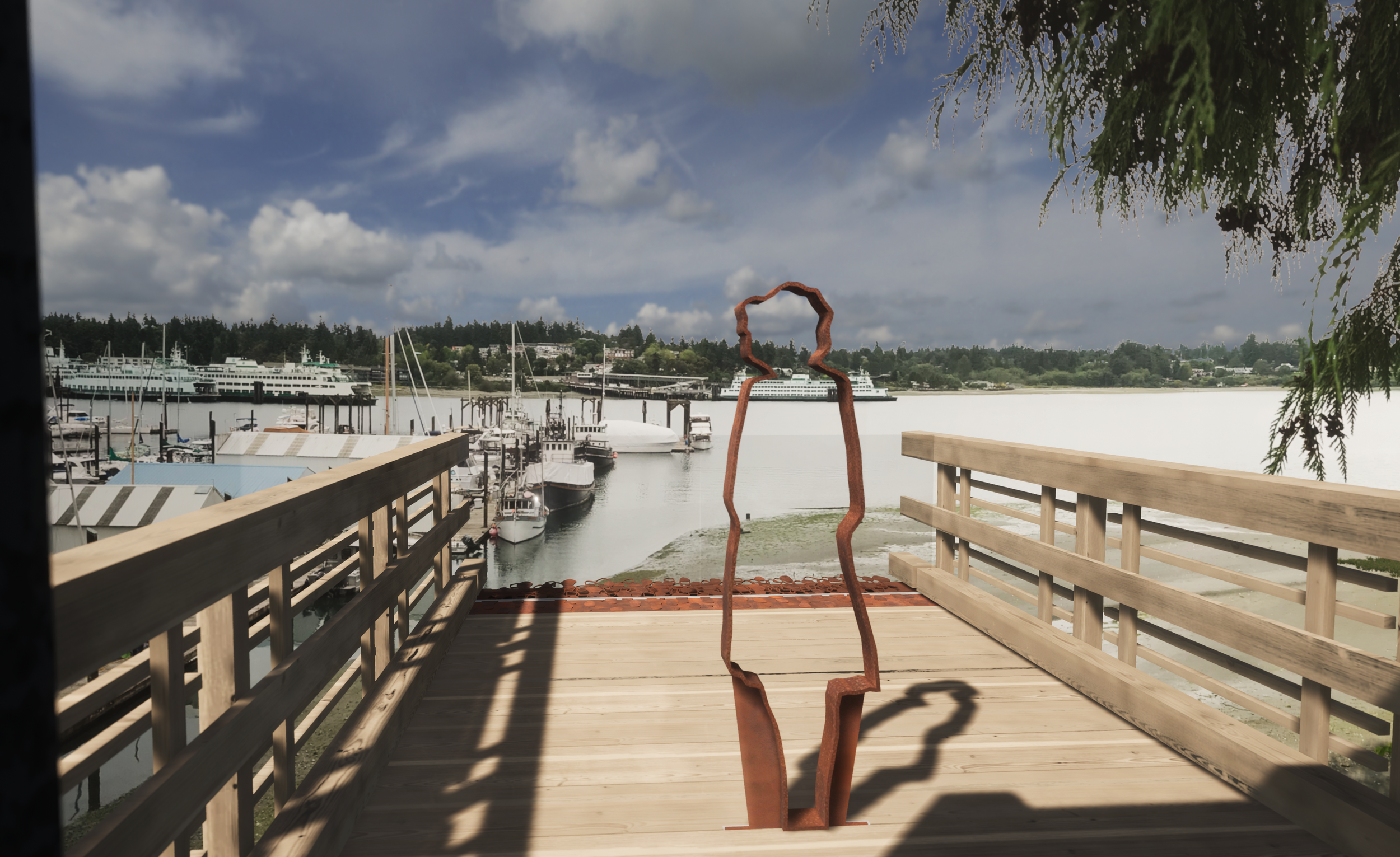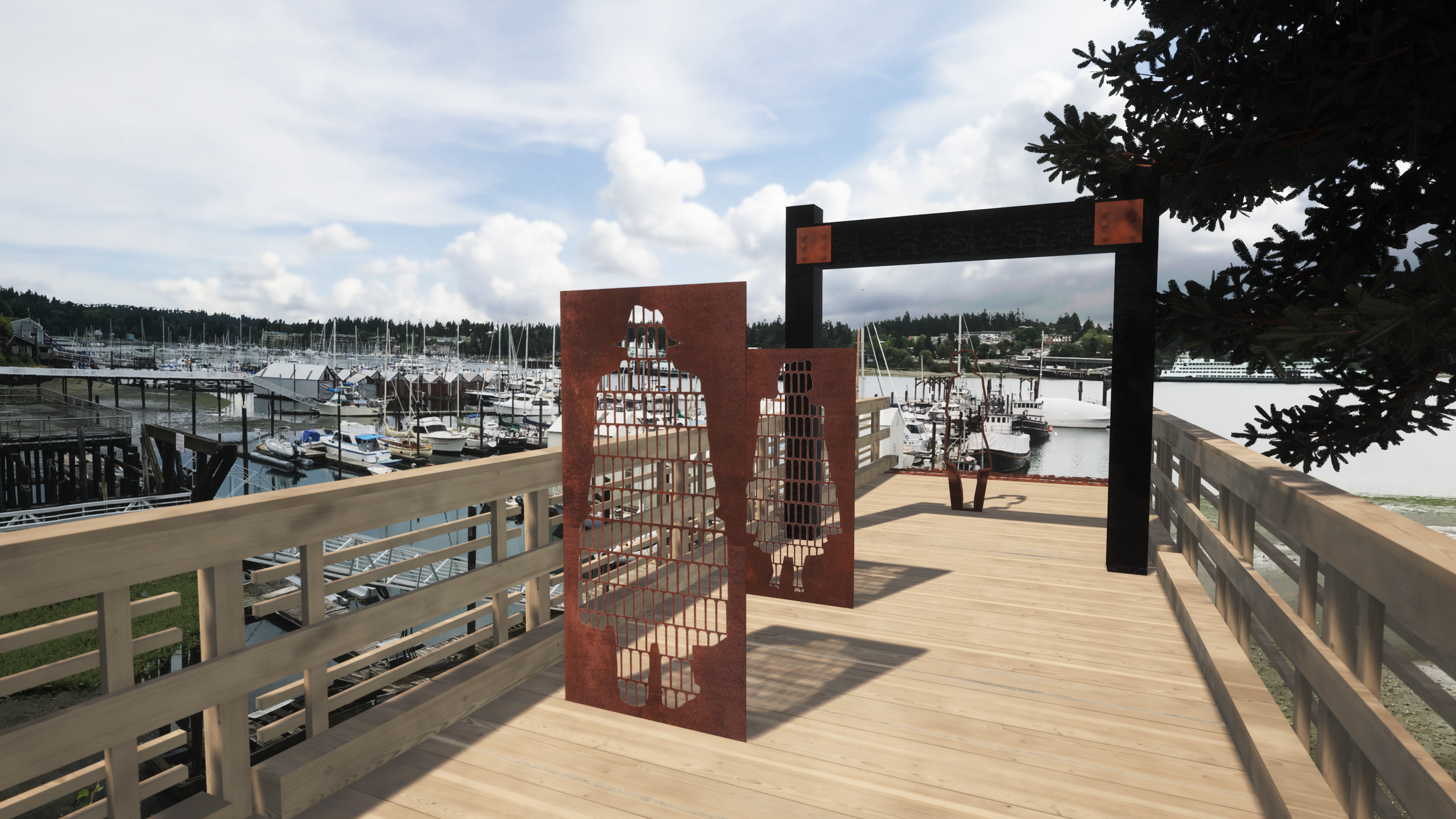let it not happen again
Honoring Japanese American history 80 years after “The Exclusion”
Words by Richard Rosenthal
Composite photo of Japanese Americans leaving Bainbridge on March 30, 1942 with present-day memorial (Photo: BIJAEMA/Paul Dunn)
Standing on the Departure Deck at the Bainbridge Island Japanese American Exclusion Memorial, it’s easy to get lost in the serenity of the setting. Across Eagle Harbor are verdant hills and the quaint community of Winslow. Closer to the deck are views of the yacht clubs at Eagledale, where boats peacefully await their next pleasure cruise. It isn’t until one looks down that the mood takes a darker shift. In the murky waters below, old pilings and scraps of wood bear silent witness to the chilling events that took place here eight decades ago.
March 30 marks the 80th anniversary of what is known as “The Exclusion.” This takes its name from Executive Order 9066 and Civilian Exclusion Order Number 1. Issued by President Franklin D. Roosevelt on February 19, 1942, the order authorized the evacuation of all persons deemed a threat to national security on the West Coast to relocation centers further inland. Because of Bainbridge Island’s proximity to naval bases, local Japanese Americans were the first in the country to be interned. Two hundred twenty seven Americans of Japanese ancestry were ordered to leave the island with only six days’ notice and were allowed to take but a few possessions. They departed from the Eagledale Ferry Dock on March 30th of that year, unsure of what awaited them.
The Departure Deck, which is nearing completion with the addition of interpretive art and signage, is intended to impart the jarring sense of uncertainty and fear those residents felt. It will stand in stark contrast to the site’s peaceful natural surroundings and gently curving Memorial Wall, constructed of granite and old-growth cedar.
“The Departure Deck is supposed to be a different part of the story,” says Bainbridge city councilman Clarence Moriwaki. “This is not a feel-good part of history. When people were leaving this site on the morning of March 30th, there was a lot of anxiety and fear. Nobody knew where they were going, how long they would be gone, or even if they would come back. There [was] a lot of anger, shame and humiliation. We want the revised Departure Deck to evoke the feeling that this was a very dark period.”
The memorial, a National Parks Historic Site, began with a simple plaque in 2002 and has expanded to include the Memorial Wall, added over a decade ago, and the Departure Deck, dedicated last year. Plans for the final phase of development include a visitor center and open-air amphitheater.
Stepping onto the deck, visitors will soon walk between two towering iron silhouettes of soldiers, bayonets pointing skyward, explains Moriwaki, former president of the Bainbridge Island Japanese American Community. Further on, visitors will encounter two more iron cutouts—those of a woman and child— before passing through an industrial-looking gate. From there, embossed footprints representing adult’s shoes, children’s shoes and soldiers’ boots lead to a wall of glass, which will replace the wood railing at the end of the deck.



Artist’s rendering of memorial’s new departure deck (Photos: Luc Revel)
Moriwaki explains that the reason for the glass is to evoke a feeling of walking into uncertainty. “When you see it from a distance, there will be only sky and water, and that’s obviously fearful,” Moriwaki says. “On the other side of the glass, the footprints will continue. These will be cutout silhouettes so that when you look down at the water, you will get a feeling of walking into the unknown.”
When people make statements such as “that was 80 years ago, it could never happen today,” Moriwaki strongly disagrees. He points to a rise in anti-Asian hate crimes amid political pandemic rhetoric that targeted China.
“Today, we are going through yet another traumatic event, the pandemic, and people again want to blame somebody. The previous administration put the blame on the Chinese and never let up on that rhetoric, using offensive phrases such as ‘China Virus’ and ‘Kung-Flu.’”
Moriwaki hesitates for a moment to regain his composure. He then continues, his voice quivering. “This is not ancient history. You are going to see survivors at the 80th anniversary who were these victims. So is this anniversary important? Hell yeah. That’s the chilling reminder of how this can happen.”
The few survivors who remain from that spring day long ago were children at the time, so their memories are limited, Moriwaki notes. “That community and group are getting smaller and smaller with each passing year, so it is more important than ever to finish the memorial as we envision it.”
Survivors and supporters may witness the updates to the memorial at this year’s March 30 commemoration, which will be livestreamed for those who can’t attend.
Information about the anniversary and related events and exhibits throughout the community in March and April is available at bijac.org.
Leaving the memorial site, one of the last things visitors see is a simple plaque with eight words. Three are transliterated from Japanese and five are in English. The words are a poignant reminder: “Nidoto Nai Yoni. Let it not happen again.”



Origami cranes, a symbol of remembrance (Photos: Richard Rosenthal)

